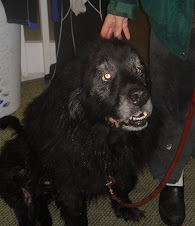Monday, April 26, 2010
Safe Swimming - Part II
Teaching Your Dog to Swim
There are ways a person can safely determine what kind of swimmer their dog is and teach them proper, safe swimming form. The easiest of these is to call the closest canine water therapy pool or equivalent in your area. SplashDog in Edmonds, where I work, gets plenty of people who want to 1. find out if their dog can safely swim, 2. teach them the safe and effective swimming techniques and 3. get them comfortable with water.
Having worked with many of these dogs, I have found one thing that is going to make the process go faster and that is to be in the water with the dog. You can do that in any safe body of water, but at the canine pools, the water is warmer, more comfortable. When you work with any dog in the water, especially for the first time, expect to get beat up a little. Their flailing paws and unpredictable movement can get you scratched up. Wear clothing that will cover your arms and your upper legs. I wear water shoes as well as it gives me better traction in the water and it can be a challenge keeping up with a panicked dog.
The key is to be calm yourself. Don't get frustrated and force your dog into the water. If they won't walk in, don't pull them in by force right off the bat. Pick them up and walk in with them. Stop when you can stand them up in the water without it being over their shoulders. Try to get them to stand up. that may involve physically putting their feet on the bottom and holding them there for a few seconds so they can feel the ground. If they won't do it or begin to become anxious begin the swim training right away.
Staying calm, breathing and speaking in a soothing and happy tone of voice is a must. If you find yourself getting frustrated or frightened, stop the session promptly. Be sure to let the dog know they are doing a good job (even if you don't think they are). Some dogs can be very anxious about the unknown. If they are not typically around water they have no idea what is going to happen. The trust between you and your dog is key to making this process work well.
Once you are at the point of the dog standing in the water or have gotten to that point and they will not stand, proceed by putting one hand under them on their belly and a forearm or hand across their chest. Gently but purposefully pull them as you walk into slightly deeper water. Don't lift their belly or propel them through the water or they will allow you to do all the work. Your contact is only for support and steering. When they begin moving their legs, keep their forelegs in the water with your forearm,, or hand for smaller dogs across the chest. If the rear end begins to sink low, lift it a bit but don't constantly hold it up.
Steer the dog back to where they can stand on their own and encourage them to stand up without letting them run off. If you let them run onto shore now, it could be a struggle to get them back into the process. Repeat the process several times. When you feel the dog begin to relax with the paddling, not flailing as much, and they are swimming back to your starting point without a lot of steering on your part, then you can let them try swimming without full contact.
Subscribe to:
Post Comments (Atom)















No comments:
Post a Comment